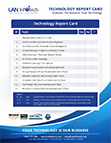How Does Ransomware Work?
Ransomware is a serious threat – not just in terms of potential cost, but also because it could end your business for good. Do you know how ransomware spreads?
Ransomware is an undeniably major threat to businesses around the world today. According to Beasley Breach Response’s 2019 noncompliance report:
- The average ransomware payout is $116,000
- The highest ransomware demanded by cybercriminals was $8.5 million
- The highest ransom paid by a target organization was $935,000
Learn all about ransomware, and how it spreads, in our latest video:
What Is Ransomware?
In a ransomware attack, an unsuspecting user clicks on a seemingly safe link or an emailed attachment that appears to be a bill or other official document. Instead, the attachment installs a malicious software program (malware) onto the computer system that encrypts the data and holds it at ransom. The user is then stuck without access to their data, and faced with paying the attacker a huge sum.
How Does Ransomware Spread?
There is a range of ways that hackers trick targets into downloading ransomware:
- Phishing: Phishing is a hacking technique that “fishes” for victims by sending them deceptive emails. Phishing attacks are often mass emails that include ransomware as an attachment.
- Malvertising: Hackers have found vulnerabilities in many popular, modern browsers like Google Chrome and Mozilla Firefox. They spam users with official-looking pop-ups informing them of an “infection” or “security alert” prompting them to download a file or click a link. That’s where the ransomware comes into play. As with so many of these methods, it just comes down to getting the user to interact with malware in some way without knowing it.
- Remote Desktop Protocol: RDP is a known infiltration point for cybercriminals, especially for unpatched systems.
- 3rd-Party Remote: Many cybercriminals are attacking third-party remote-control tools as they know that once they can gain access to a remote control tool, they will have access to several machines that can be infected.
- Out Of Date Hardware: Many of the most common malware and viruses used by cybercriminals today are based on exploiting those programming flaws; to address this, developers regularly release software patches and updates to fix those flaws and protect the users.
Are You Protected From Ransomware?
LAN Infotech offers comprehensive cybersecurity services to protect businesses like yours against ransomware. If you’re not getting the support you need from your current IT company, then you should consider making a change.
Like this article? Check out the following blogs to learn more:
Implement These 5 Tips To Insulate Your Systems From Hackers And Spies During This COVID-19 Pandemic
Remote Connectivity Risks The COVID-19 Crisis Created
Technology Security Tips for Businesses Working Remotely

LAN Infotech is a Microsoft Cloud Services Provider, IT Managed Support company and a leader in helping law firms, nonprofits and medical organizations deploy cloud solutions, manage computer networks, keep data protected and top technology management company. Businesses like yours need technology support to run highly-effective organizations.


